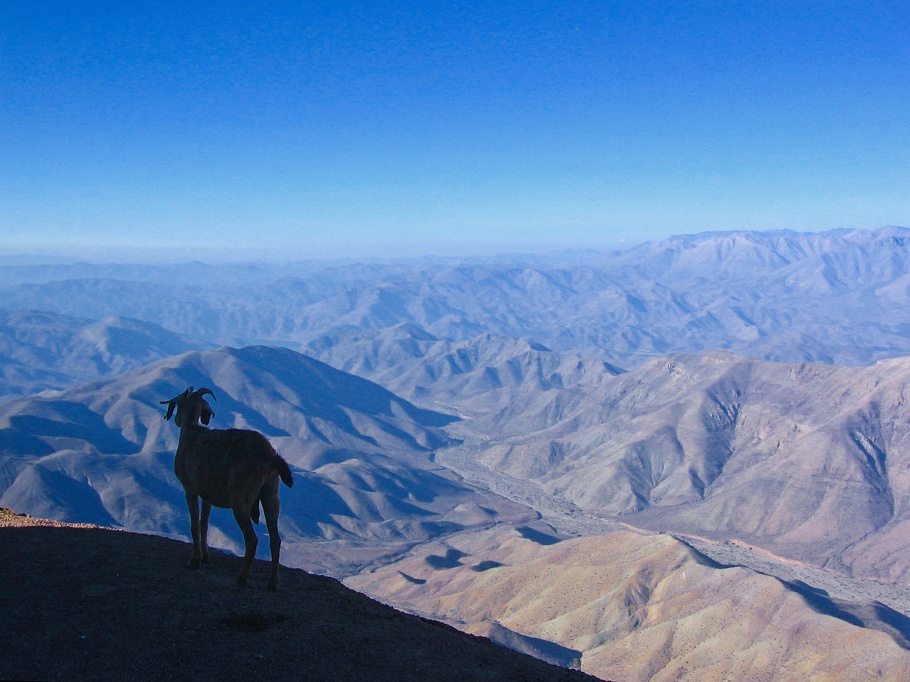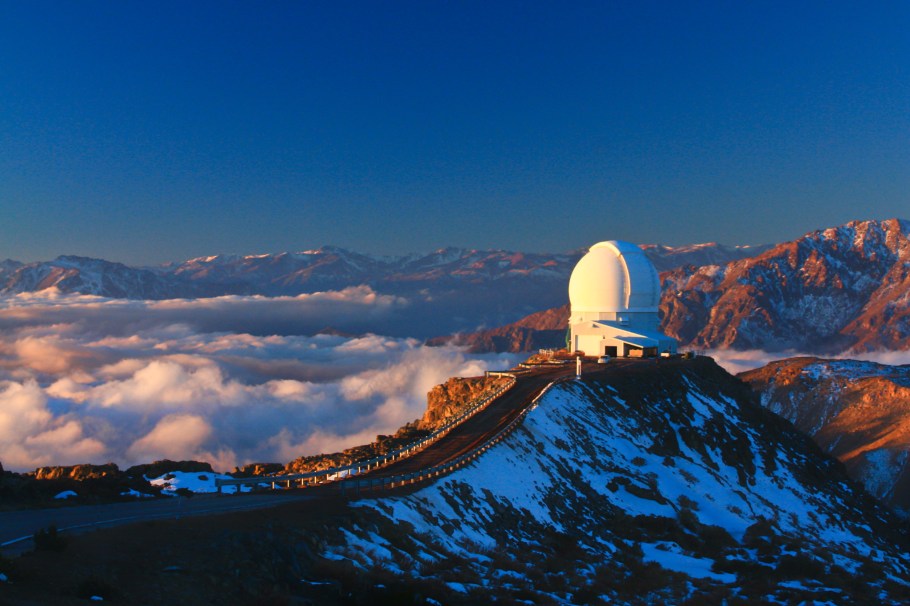Under the desert sun
Above/featured: Ruta 5 (highway 5), a ribbon-like cut through the desert in Región de Atacama, Chile – 24 Nov 2009 (450D).
It’s an interesting question: how does one consider, view, or photograph what’s under the sun? There’s a lot of room for interpretation. Modifying the theme for the desert sun, I examine the “quality of sunlight” within the Atacama Desert in northern and north-central Chile, and within the Sonoran Desert in southwest United States.
North-central Chile
Chile is known for a great place to set up telescopes because (a) the Andes provide many mountain candidates; (b) the mountains are for the most part far from cities and their “light pollution” at night; (c) onshore winds from the Pacific flow in laminar fashion in many places over the Andes, providing good stable viewing conditions; and (d) there’s ample support and infrastructure. An extra bonus is the extent of the Atacama desert, providing potentially low water vapour and favourable conditions for observations in the thermal infrared.
The first time I visited Chile was in 1995, as a visiting astronomer to a 60-cm telescope managed and operated by the University of Toronto. I returned to various other observatories in Chile several times in the following ten years, and because of the stark impressive beauty of mountains and desert, I viewed each trip as my last. How was I to know I’d spend 5 years in Chile, beginning in 2006, and a “regular” at the summits of two mountains.
Dates: 2007, 2009, 2010.
Location1: Cerro Tololo with elevation 2207 m / 7241 ft, at -30.168969, -70.806341 (30.168969 South, 70.806341 West)
Location2: Cerro Pachón with elevation 2715 m / 8907 ft, at -30.240736, -70.736578 (30.240736 South, 70.736578 West).

3 Andean foxes (zorros) day-napping in early-winter sun at Cerro Tololo – 26 Jun 2007 (A510).

Cerro Pachón (centre), from Cerro Tololo – 26 Jun 2007 (A510).

Goat (cabra) surveying the desert landscape, from Cerro Tololo – 24 Dec 2007 (A510).

Late on a winter day in July with Cerro Tololo (lower right), from Cerro Pachón – 9 Jul 2009 (450D).

Winter afternoon in July, the SOAR telescope from Cerro Pachón – 15 Jul 2010 (450D).
Northern Chile
My colleagues and I flew out from La Serena to Antofagasta for a visit to the European Southern Observatory Very Large Telescope facility (ESO VLT) at the summit of Cerro Paranal. It’s warm on this late-spring day in November, and dust blows across the highway in brisk winds on our drive through the Atacama desert. It’s very dry in this part of the world; stories are told about how some of the weather gauges placed in the desert go back decades having recorded zero precipitation.
Date: 24-25 November 2009.
Location: Cerro Paranal with elevation 2635 m / 8645 ft, at -24.627088, -70.403982 (24.627088 South, 70.403982 West).

Roadside shrine on the Carretera Panamericana (Panamerican Highway), known to most as Ruta 5 (450D).

ESO 8-metre diameter Unit Telescopes (UT) at Cerro Paranal (450D).

At left and right, respectively, are the UTs and hotel residencía for visiting scientists’ required daily quanta of solace (450D).

Surrounding barren landscape, both mountainous and the Atacama Desert (450D).
Tucson, AZ
Towards the final stage of our two-week drive within the American Southwest, we headed south from Flagstaff to Tucson where we stayed for a couple of days. A highlight was the Arizona Sonora Desert Museum whose flora and fauna exhibits are available inside and outside, much of it representative of the surrounding Sonoran Desert. Returning to Tucson was a reminder of previous visits to the observatory at Kitt Peak.
Date: 18 October 2018.
Location: Arizona-Sonora Desert Museum with elevation 870 m / 2854 ft, at 32.244085, -111.168191 (32.244085 North, 111.168191 West).

Solitary saguaro at a local stay (6D1).

Arizona-Sonora Desert Museum: whiptail lizards “stubby” and “whipper” at lower-left and upper-right, respectively (6D1).

Arizona-Sonora Desert Museum: facing southwest towards the Baboquivari Range (left) and Quinlan Mountains (right) in the background. Labelled are Baboquivari Peak (2356 m/7730 ft), sacred location for the Tohono O’odham people; and the Kitt Peak National Observatory (2098 m/6883 ft). The line-of-sight distances to these two peaks are 66 km (41 mi) and 51 km (32 mi), respectively. Photo with 6D1.

Prairie dog, Arizona-Sonora Desert Museum (6D1).

Last light of the day, at the outer edge of Saguaro National Park West (6D1).
I made all images above within the Canon family: PowerShot A510 (A510), EOS450D/Rebel XSi (450D), and EOS6D mark1 (6D1). Acknowledgements go to Amy for LAPC no. 109 in the week of 8-14 Aug 2020. This post appears on Fotoeins Fotografie at fotoeins DOT com as https://wp.me/p1BIdT-iGR.

9 Responses to “Under the desert sun”
A beautiful and interesting post Henry. Although I agree the sunlight in different areas of the world is a wonderful way to approach the challenge, I find myself drawn to the goat and the prairie dog. Does that make me too plebeian?! 😀
LikeLiked by 1 person
Not at all, Tina; I wanted to include some fauna to provide scale and perspective from our furry quadruped friends. It’s why I included the Andean foxes which are the size of small dogs: lovable but very wild. Thanks for your kind comment!
LikeLike
Amazing landscape images, Henry! I feel lucky to take a virtue tour with you to these part of the world. The opening image is stunning.
the SOAR telescope, Wow!!! The maps here in informative.
Thank you for taking time joining in!
LikeLiked by 1 person
Glad you enjoyed the images, Amy, and thanks for your kind comment!
LikeLiked by 1 person
Wow. Great photos of seldom seen areas, save Tucson, perhaps. Excellent.
LikeLiked by 1 person
Thanks, John!
LikeLiked by 1 person
Absolutely breathtaking, Henry. I think my favorite is the goat image – once we met a goat standing like that in a mountain landscape, but when I stopped to admire it, it limped away, looked like a broken leg. I kept thinking of that goat for the rest of the day. I wonder how long it really managed.
LikeLiked by 1 person
Although the goat in the image seemed fine, I asked myself: is it on its own? If not, where’s the rest of the family? Is there enough to eat and drink in this very parched landscape? As much as any visitor wants to, we’re told not to feed the goats or the small zorros, like any good policy towards animals in the wild. Thanks for your comment, Ann Christine!
LikeLike
And yes, I can imagine your thoughts – that is the way I work as well.
LikeLiked by 1 person